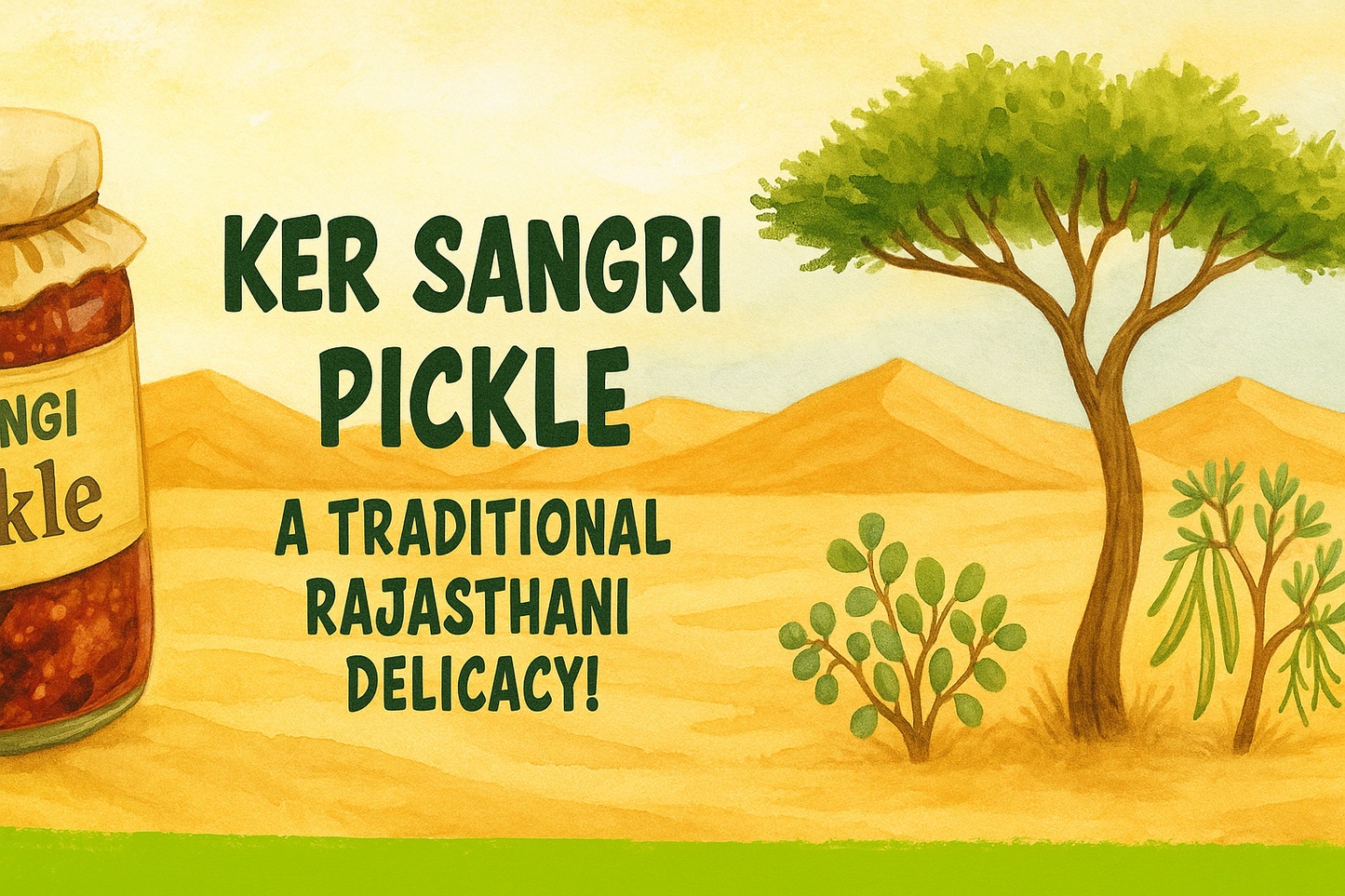
Origin and Cultural Roots of Ker Sangri Pickle
Ker Sangri pickle has originated in the desert regions of Rajasthan, India, especially areas like Jodhpur, Bikaner, and Barmer. It is a Rajasthani Delicacy deeply rooted in the Marwari Cuisine.

Ker Sangri pickle is also referred to as the “Legend of the Famine” as people resorted to boiling and spicing up Ker Sangri with the locally available ingredients like mustard oil, salt and spices. This story goes back to the time of the 17th and 18th century when there was a time of famine in Rajasthan and common vegetables were unavailable.
Pickling of ker sangri became a method of preserving these seasonal ingredients. The ker sangri pickle served as a nutritious and flavourful accompaniment during dry months. This necessity-born pickle has now become a beloved part of the regional cuisines.
It is now a cultural staple, especially during traditional weddings, festive meals and cultural thalis. It is also considered a pure (sattvic) food when prepared without onion and garlic.
What is Ker and Sangri?
Ker - Botanically also known as capparis decidua, Ker is a small, green, berry-like fruit typically harvested in the months of April and May, particularly in places like Rajasthan, Gujarat, and Punjab. It is drought-resistant containing nutrients like protein, carbohydrates, fibers, etc. It also has antioxidants that help in reducing stress and chronic diseases. To make it ready for culinary use, the preparation involves soaking the fruit in buttermilk for several days to remove the bitterness, followed by drying for preparation.
Sangri - Sangri pods grow in the Khejri tree, a thorny evergreen that grows to around 5 meters in height. Botanically also known as prosopis cineraria, it grows in dry regions. Sangri is used as a vegetable and is prized for its unique taste and nutritional benefits. Rich in potassium, magnesium, and calcium, it is also a good source of protein and fiber. In order to be cooked, it has to be soaked for a minimum of three hours. In India, sangri is mainly found in the Thar Desert, where it is said to have originated.
Data Source - Speciality Produce


How is Ker Sangri Harvested?
Harvesting these products involves a lot of effort, as harvesting sangri involves one person to climb atop the Khejri tree or use a ladder to pick the pods manually 15 days after they bloom in the months of April and May along with twigs while tackling the prickly thorns. The pods, once foraged from trees, cannot be consumed directly.
They are then boiled for 30-45 mins in a deep pot till they soften a little and then beneath the sun. That becomes the product that is sold in the market to further make ker sangri. If packed properly, it can be stored and consumed over seven to eight years.
Similarly, the unripe pods of ker are also harvested during the months of April and May and used for making a variety of pickles and vegetarian dishes.What Makes Ker Sangri Pickle Different From Other Pickles?
While other pickles are made with very conventional ingredients, the names of which we hear on a regular basis, Ker Sangri Pickle is made by wild pods that grow in arid regions in very harsh conditions. Where other pickles are made using mangoes, jackfruit, lemon, etc, ker and sangri become a show-stealer.
It is also different as it has a very interesting backstory attached to it. It helped people in some really difficult times when there was no other alternative food available. As it is grown in arid regions, unlike other ingredients, it is not for consumption in its raw form. It has to go through a method in which it is soaked and that makes it edible.
Ker Sangri Pickle is truly special! 🌟 It’s made from desert plants that survive in tough conditions, and people turned them into food during hard times. With soaking and care, these wild pods become a tasty pickle that carries history, tradition, and unique flavors.
Iski subji bhi banti hai.
Agar usko manufacture kar sakte ho to USA, UK, UAE mein jabardast dhoom machayega. Achaar to banta hi hai aur bikta bhi hai. Par subji nahi.
Try karie.